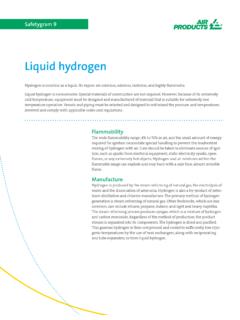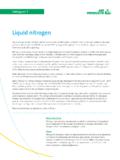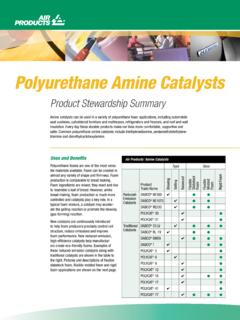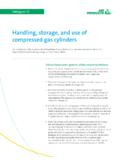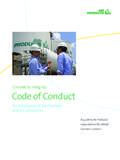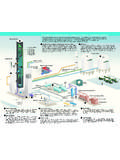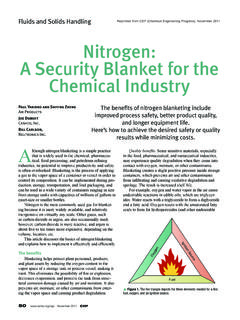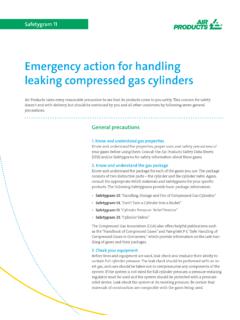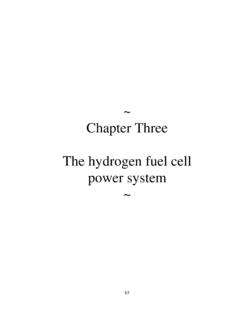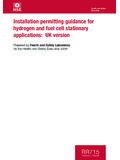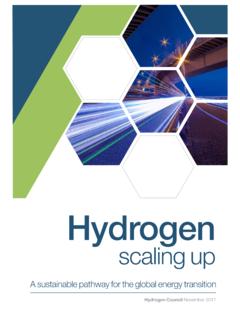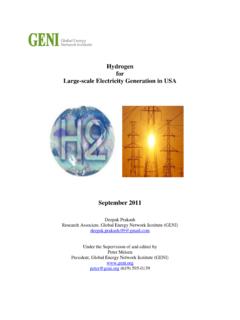Transcription of Gaseous hydrogen - Air Products & Chemicals
1 hydrogen is a colorless, odorless, tasteless, highly flammable gas. It is also the lightest-weight gas. Since hydrogen is noncorrosive, special materials of construction are not normally required. Vessels and piping must be selected and designed to withstand the pressure and temperatures involved and comply with applicable codes and 1 shows physical properties of Gaseous hydrogen . As indicated by the specific gravity, hydrogen gas is much less dense than air and can disperse rapidly or accumulate in the upper sections of enclosed hydrogenFlammability The wide flammability range, 4% to 75% in air, and the small amount of energy required for ignition necessitate special handling to prevent the inadvertent mixing of hydrogen with air. Sources of ignition, such as sparks from electrical equipment, static electricity, open flames, or extremely hot objects, should be and air mixtures within the flammable range can explode and may burn with an almost invisible hydrogen is produced primarily by the steam reforming of natural steam reforming process produces syngas, which is a mixture of hydrogen and carbon monoxide.
2 The product stream is separated into its components, and the hydrogen is dried, purified, and compressed into cylinders, pipelines, or tubes for hydrogen is used in manufacturing processes for producing petroleum, steel, Chemicals , foods and electronics. Refineries use hydrogen to produce cleaner burning gasoline and low sulfur diesel fuel, helping to reduce air the metallurgical industry, hydrogen is used to reduce metal oxides and prevent oxidation when heat-treating certain metals and alloys. It is also used as a fuel in alternative energy vehicles and may be used when welding and cutting metals. hydrogen is also used by semiconductor manufacturers, primarily to form reducing atmospheres, and it is used in the chemical industry to synthesize ammonia and 42 Health hydrogen gas is odorless and nontoxic but may induce suffocation by dilut-ing the concentration of oxygen in air below levels necessary to support amount of hydrogen gas neces-sary to produce oxygen-deficient atmospheres is well within the flam-mable range, making fire and explo-sion the primary hazards associated with hydrogen and air hydrogen may be supplied in cylinders or in tubes that are designed and manufactured according to appli-cable codes and specifications for the pressures and temperatures involved.
3 The pressure rating and internal volume of a container determines the quantity of hydrogen it can hold. Cylinders may be used individually or can be manifolded together to allow for a larger gas storage are mounted on truck-trailer chassis or in ISO frames for trans-portation and are referred to as tube trailers or tube modules, respectively. Stationary tube (also called hydril tube) modules store large quantities of hydrogen at customer bulk Gaseous hydrogen customer storage system commonly consists of 3 to 18 tubes with total capacities up to 150,000 standard cubic feet (>4,250 m3) of hydrogen . Stationary storage tubes have individual valves and safety de-vices and are manifolded together so the customer can withdraw product from a single tube or multiple tubes. Customer storage systems are com-monly filled to 2,400 psig (165 bar). Portable and stationary Gaseous hydrogen fueling systems with service pressures up to 7,500 psig (500 bar) are also in 1: Gaseous hydrogen Physical and chemical PropertiesChemical Formula H2 Molecular Weight Point at 1 atm 423 F ( C)Freezing Point at 1 atm 435 F ( C)Critical Temperature 400 F ( 240 C)Critical Pressure 186 psia ( bar)Density, Gas at 70 F (21 C), 1 atm ( g/l)Specific Gravity, Gas (air=1) at 68 F (20 C), 1 atm Volume at 70 F (21 C), 1 atm ft3/lb ( m3/kg)Latent Heat of Vaporization 192 Btu/lb (446 kJ/kg) Flammable Limits at 1 atm in air 4% 75% (by volume)Autoignition Temperature at 1 atm 1040 F (560 C)SpecificationsIn the United States, cylinders and mobile tubes are manufac-tured according to Department of Transportation (DOT)-3A or DOT-3AA specifications.
4 Cylinders and mobile tubes are hydrostatically tested upon manufacture and tested periodically thereafter at 5/3 times the service pressure as specified by DOT regula-tions. hydrogen may be stored in ASME coded and stamped, National Board registered high-pressure gas storage tubes as part of a stationary installation. These tubes are hydro-statically tested by the manufacturer but, unlike cylinders and mobile tubes, they do not require periodic hydro-static : hydrogenCompliance with applicable Dangerous Goods regulations is required for all shipments by motor freight, rail, air and water. These regu-lations describe the marking, labeling, placarding, and shipping papers re-quired. International shipments by air must comply with International Air Transport Association/International Civil Air Organization (IATA/ICAO) Dangerous Goods regulations. Final acceptance for air transport is at the discretion of the airline. International shipments by water must com-ply with International Maritime Organization (IMO) Brass pressure seal or o-ring seal valves are typically used on cylinders and tube trailers.
5 The standard hydro-gen cylinder valve outlet connection in North America is the CGA 350 for pressures up to 3,000 psig. Different connections are used for hydrogen in other locations based on national or regional standards. Further informa-tion on valves and valve outlet con-nections is provided in Air Products Safetygram 23, Cylinder Valves, and Safetygram 31, Cylinder Valve Outlet Connections. Pressure relief devices Pressure Relief Devices (PRDs) are employed to reduce the likelihood of container failure in fire situa-tions. These devices take the form of frangible disks, fusible metal plugs or pressure relief North America and Asia, pressure relief devices are commonly integral parts of the cylinder valves and are installed on both ends of portable and stationary tubes. In Europe, PRDs are not commonly used on Gaseous hydrogen cylinders or on portable or stationary bulk containers. For further information on PRDs, consult Safetygram 15, Cylinder Pressure-Relief Devices.
6 Safety considerations The hazards associated with handling Gaseous hydrogen are fire, explosion, and pressure. Although hydrogen tends to dissipate quickly, its mini-mum ignition energy is extremely low, allowing relatively easy ignition of hydrogen mixtures in the flamma-ble range. hydrogen is easily ignited by open flames, electrical sparks and static electricity. hydrogen may deto-nate and ignite when rapidly vented into the air. hydrogen burns with an almost invisible flame, and severe burns may result from unknowingly walking into a hydrogen fire. The fire and explosion hazards can be controlled by appropriate design and operating procedures. Preventing the formation of combustible fuel-oxidant mixtures and removing potential sources of ignition (electric spark, stat-ic electricity, open flames, etc.) in areas where the hydrogen will be used are essential. Adequate ventilation will help reduce the possible formation of flammable mixtures in the event of a hydrogen leak.
7 hydrogen s autoignition temperature (AIT) is 1040 F (560 C). The AIT is the minimum temperature required to initiate self-sustained combustion. The relatively high autoignition temperature makes ignition of a hydrogen /air mixture unlikely from heat alone without an additional ignition prevent the formation of flam-mable mixtures, Gaseous hydrogen systems must be purged of hydro-gen before opening the system to the atmosphere, and purged of air, oxygen, or other oxidizers prior to admitting hydrogen to the systems. If the piping systems are extensive or complicated, multiple purging and evacuation cycles may be required for optimum results. Purging can be done using system evacuation, inert gas pressuring-depressuring cycles (cycle purging), flowing inert gas through the equipment or combinations of these methods. System configuration considerations, including total vol-ume, inclusion of piping dead ends, and availability of evacuation capabil-ity, should all be taken into account when selecting the purging methods to be opening a hydrogen -filled system to the air, the hydrogen con-centration should be reduced to well below the lower flammable concen-tration (4%).
8 The hydrogen concentra-tion should be reduced to well less than 25% of the lower flammable concentration (below 1% actual).Before introducing hydrogen into sys-tems that were open to air, the oxygen concentration in the system should be reduced to less than 1% (well below the minimum oxygen concentra-tion needed for hydrogen ignition). Additional purging will often be needed to meet higher-purity applica-tion handling and useCompressed gas cylinders must be stored properly, handled correctly, and used with the appropriate equip-ment to reduce the risk of incidents and injuries. Safetygram 10, Storage, Handling and Use of Compressed Gas Cylinders, describes good practices. CGA s publication P-1, Safe Handling of Compressed Gases in Cylinders, also provides safe handling aware that refilling and shipping a compressed gas cylinder without consent of the owner is not Electrical equipment within 15 feet (4 meters) shall be in accordance with Article 501 of the National Electrical Code for Class 1, Division 2, Group B locations or in compliance with alternate codes where used.
9 Gaseous hydrogen storage vessels and associated piping must be elec-trically bonded and grounded. If protective walls or roofs are pro-vided, they should be constructed of noncombustible materials. If the enclosing sides adjoin each other, the area should be properly vented. The area within 15 feet (4 meters) of any hydrogen container should be kept free of dry vegetation and combustible material. Adequate lighting shall be provided for nighttime transfer operations where appropriate. The hydrogen storage location should be permanently placarded: hydrogen Flammable Gas No Smoking No Open Flames, or storage systems Provide adequate ventilation, particularly near roof areas where hydrogen might collect. Forced ven-tilation may be necessary in some applications. All vents should be piped to the exterior of the building and must be installed in accordance with local regulations. The atmosphere in areas where hydrogen gas may collect should be monitored with portable or con-tinuous flammable gas air monitors calibrated for hydrogen .
10 Where large quantities of hydrogen can be released indoors, provide an explosion-venting surface or vents, taking care to vent a pres-sure wave to areas where people or other equipment will not become involved. Explosion vents may not be required where small quantities of hydrogen are involved. Electrical equipment must conform to electrical codes in any area clas-sified as hazardous (where elevated hydrogen gas concentrations can exist). Building materials should be noncombustible. hydrogen storage inside a building should not be near oxidants or other combustible materials storage.* Publication is available from NFPA, 1 Batterymarch Park, Quincy, MA 02169-7471 Gaseous hydrogen siting recommendationsGeneral Air Products can provide site-specific location recommendations for bulk Gaseous hydrogen installations. The system should be located so it is readily accessible to delivery equip-ment and to authorized personnel. It is preferable to locate all bulk gas-eous hydrogen systems outdoors.
